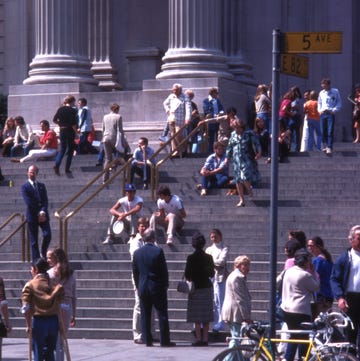“Intelligent luxury” Philip Blackwell has said, is a properly curated hotel library. Blackwell has been in the business of installing thoughtful and stylish collections in commercial and residential spaces under the auspices of the Ultimate Library since 2008. “If a hotel should be a home away from home, but better, then it follows that the book collection needs to be intelligently selected,” Blackwell once told Hospitality Design.
What’s an intelligent selection? One that not only anticipates its readership but aligns with the design and geographic situation of the space in which it’s found. But, you might be thinking, a lot of hotels have libraries that are by no means carelessly compiled, right? Here’s the distinction: Some hotels put books on shelves, others want what’s inside the books to inform guests’ experience. For the latter, careful curation is key. Because unlike other objects in a room, books talk back.
At The Mercer hotel, in New York City, floor-to-ceiling shelves are filled with art and photography books selected by Dashwood Books, whose curation services have been used by retail outlets of luxe labels (e.g. Gucci) and private homes. The Mercer is in Soho, a neighborhood with deep history and long associated with its artistic and fashion sets, which also comprises the area's current crowd. A collection of art books serves its audience perfectly. Similarly, the Zulal Wellness Resort, in Qatar, features over 1,200 books chosen by the Ultimate Library to “give guests from around the world an insight into Qatari culture and ancient medicinal practices.”
This June, the Sylvia Hotel in Newport, Oregon is set to reopen, after a considerable renovation, with seven author-themed rooms, each filled with books curated to match, as well as literary themed rooms. The collection available throughout the hotel will be hand-picked by staff, says Jenny Nelson, vice president of operations, with input from local shops like Powell's, in Portland. Key to the curation and renovation is the concept of community building, and honoring the life and work of the hotel’s namesake, Sylvia Beach, the iconic bookseller without whom James Joyce’s Ulysses would not have been published, though Beach is probably best known as the owner of Shakespeare and Company, in Paris.
And at the Kimpton, Palomar, in Philadelphia, Bedside Reading plants books on nightstands to “provide opportunities for guests to find their next great read." Because the hotel is in the old Architects Building in Center City, a historic art deco structure erected in 1929 that once housed the Philadelphia Chapter of the American Institute of Architects, the Palomar offers “a dedicated library space, the AIA Library, as a nod to the many skilled architects who have contributed to Philadelphia.”
Creating libraries like these requires a complicated math, but one that hotels, large and small, are increasingly investing in for the undeniable (albeit hard to measure) return: To be known as the hotel that offers a carefully curated library is incredibly chic.
It’s also the ultimate expression of bookshelf wealth, a trend doing concrete numbers on TikTok. Books and reading, despite doomsayers, are popular. Consider the continued momentum of book clubs, and all the celebrities who love posing with their books (Marc Jacobs just finished Flowers for Algernon; Lebron James famously reads before games, and Pauline Chalamet keeps a robust, public list of recs). The pleasure of reading from a book—the tactile satisfaction of turning a page and cracking a spine; looking at dust jackets and considering the art as a moment in history—is unbeatable, and one that has only gained in value as technology suggests its obsolescence.
In Carmel-by-the-Sea, California, the collection at La Playa Hotel “is fully intended to be a tangible and sensory-rich experience,” says Jess Martin, director of brand management. “The bindings are accessible, touchable, and readable… The books are dispersed thoughtfully throughout our rooms, inviting guests to peruse their pages at their leisure.”
Curated by Ellipsis Rare Books, the collection at La Playa is also deeply researched to reflect the historical significance of the hotel as well as the region. Carmel, if you’re not familiar, was considered a hotbed for artistic and literary activity around the turn of the last century. And La Playa, built in 1905, was first a bohemian retreat, artist residence, and atelier. When the hotel underwent a massive renovation, completed in 2023, the book collection was updated with the specific goal of showcasing works that connected to “the local literary movements, La Playa’s history, and the surrounding environment.”
Represented in the current collection are “writers and poets such as Mary Hunter Austin, Robinson Jeffers, and George Sterling,” who “called Carmel home.” All the books are vintage, primarily circa 1950 – ‘60, though the exact range is from “before the 1906 earthquake to the countercultural movements.” Familiar names such as John Steinbeck, Jack London, Henry Miller and Jack Kerouac show up alongside those of writers whose work helps tell the story of “California’s literary and sociopolitical movements." There are also books about artists who made work in the area or who were associated with its movements, from Ansel Adams to Edward Weston and Xavier Martínez.
Ellipsis Rare Books, run by married couple Andrew Lenoir and Charlotte Anderson and known for "rare, out-of-print, unique, and unusual books and ephemera pertaining to weird fiction, unusual history, counterculture, quackery, occultism, spiritualism, and alternative spirituality" used a couple of texts that described Carmel's bohemian heyday as primary jumping-off points and inspiration for the collection's composition. They also drew from their existing bibliography, contemporary publications, and newspaper articles.
The result is a library that “does offer a subliminal yet meaningful emotional connection,” says Martin. “From curation to placement, the guest's journey of discovering each book is designed to be a story in itself… Each work was carefully chosen to not only spark intrigue but offer a deeply enriching and unexpected experience our guests are unlikely to encounter elsewhere.”
And it’s true that while the popularity of collections like these is increasing, they are by no means the rule. There is risk involved in the hyper-curated hotel library, and that is to be judged by it: A curated collection telegraphs the taste and interests of the person or entity who built the collection. When found in a private residence, books “tell you something about the people who live in the house,” as Architect Pietro Cicognani of Cicognani Kalla Architects told ELLE decor a few years ago. Ideally, what those books say is: “‘These are people who think, who have interesting lives and discuss interesting things.’”
To bypass the risk of having its character reduced to the value of its collection while still benefiting from the power of books to make a space feel lived in, hotels have been known to fill libraries with a whole lot of books that stand for the idea of a whole lot of books. But this has its risks, too: You will be judged for it. Recently, book dealer Christopher de Lotbinière was invited for a drink at a very well-known, luxury hotel in Paris (that will go unnamed). In honor of a writer said to have spent hours at a corner table observing guests, the hotel created a glamorous sitting room—filled with a mix of decorative and real books. “I was shocked,” says de Lotbinière. “This amazing salon and they had fake books. Completely fake and stuck into the wall. I was shocked.” Though some are real, as the team behind the room confirmed, the mere presence of fake books can undermine the endeavor wholesale. For the literary tourist, it’s not just books on a shelf, but which books and on which shelf that matters.
This isn’t to say that aesthetics is not part of the equation. Book jackets, in fact, inform the value of books: With a perfectly intact jacket, a book’s value can jump hundreds or thousands of dollars. For example, says de Lotbinière, the James Bond books by Ian Fleming, though not of “great literary significance,” are “fanatically collected,” because they have distinctive jackets (and there are only twelve in the series). Depending on the quality of the jacket, a first edition of the very first Bond book can fetch something like $75,000; at the moment, there’s a copy of Casino Royale on eBay for $25,000.
Most book jackets, says de Lotbinière, can be viewed as artworks representative of the era in which they were made. “Very much like a painting, you can tell if the work is from the ‘30s or ‘60s or ‘80s, and the same with book jackets.” And so, just as a painting would, book jackets help set the tone for the room they’re in, which is why curated collections, in private and commercial spaces, will often be culled from a bracketed time period to help them cohere with the overall design.
But a collection can't be built on aesthetics alone. “My worst fear,” says de Lotbinière, is a color-coded collection, where the books are arranged by color or have had their jackets removed and replaced with gray paper. As a design element, books can’t be silenced. They can however be stolen. “We have the occasional property write on their bookplates, ‘Don’t take me, take the toiletries,’” Blackwell has said. And maybe this is one reason why the visionaries behind the hotels investing in curated, antique or rare book-filled libraries have yet to list them under their hotel’s amenities. Or maybe this is us offering a hint: Hotels, your bookshelf wealth is an amenity.














